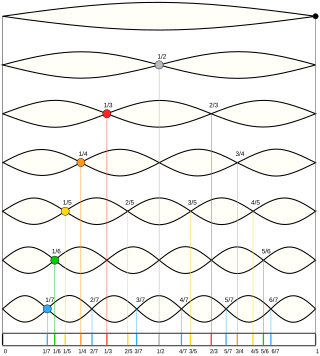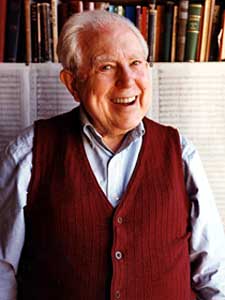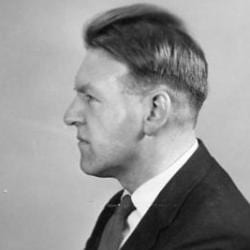Related Research Articles

A harmonic is a wave with a frequency that is a positive integer multiple of the fundamental frequency, the frequency of the original periodic signal, such as a sinusoidal wave. The original signal is also called the 1st harmonic, the other harmonics are known as higher harmonics. As all harmonics are periodic at the fundamental frequency, the sum of harmonics is also periodic at that frequency. The set of harmonics forms a harmonic series.

Elliott Cook Carter Jr. was an American modernist composer. One of the most respected composers of the second half of the 20th century, he combined elements of European modernism and American "ultra-modernism" into a distinctive style with a personal harmonic and rhythmic language, after an early neoclassical phase. His compositions are performed throughout the world, and include orchestral, chamber music, solo instrumental, and vocal works. The recipient of many awards, Carter was twice awarded the Pulitzer Prize.

Law and economics, or economic analysis of law, is the application of microeconomic theory to the analysis of law, which emerged primarily from scholars of the Chicago school of economics. Economic concepts are used to explain the effects of laws, to assess which legal rules are economically efficient, and to predict which legal rules will be promulgated. There are two major branches of law and economics; one based on the application of the methods and theories of neoclassical economics to the positive and normative analysis of the law, and a second branch which focuses on an institutional analysis of law and legal institutions, with a broader focus on economic, political, and social outcomes, and overlapping with analyses of the institutions of politics and governance.

Walter Hamor Piston, Jr., was an American composer of classical music, music theorist, and professor of music at Harvard University.

Howard Harold Hanson was an American composer, conductor, educator, music theorist, and champion of American classical music. As director for 40 years of the Eastman School of Music, he built a high-quality school and provided opportunities for commissioning and performing American music. In 1944, he won a Pulitzer Prize for his Symphony No. 4, and received numerous other awards including the George Foster Peabody Award for Outstanding Entertainment in Music in 1946.

Musical set theory provides concepts for categorizing musical objects and describing their relationships. Howard Hanson first elaborated many of the concepts for analyzing tonal music. Other theorists, such as Allen Forte, further developed the theory for analyzing atonal music, drawing on the twelve-tone theory of Milton Babbitt. The concepts of musical set theory are very general and can be applied to tonal and atonal styles in any equal temperament tuning system, and to some extent more generally than that.
In music, a hexachord is a six-note series, as exhibited in a scale or tone row. The term was adopted in this sense during the Middle Ages and adapted in the 20th century in Milton Babbitt's serial theory. The word is taken from the Greek: ἑξάχορδος, compounded from ἕξ and χορδή, and was also the term used in music theory up to the 18th century for the interval of a sixth.
William Allaudin Mathieu is a composer, pianist, choir director, music teacher, and author. He began studying piano at the age of six, and began recording his music and compositions in the 1970s on his record label, Cold Mountain Music. Mathieu has composed and recorded solo piano works, chamber pieces, choral music, and song cycles, and he has written four books on music, music theory, and how to live a musical life.
In the field of dialectology, a diasystem or polylectal grammar is a linguistic analysis set up to encode or represent a range of related varieties in a way that displays their structural differences.
Harmonium is a composition for chorus and orchestra by the American composer John Adams, written in 1980-1981 for the first season of Davies Symphony Hall in San Francisco, California. The work is based on poetry by John Donne and Emily Dickinson and is regarded as one of the key compositions of Adams' "minimalist" period.

A level, also "tonality level", Gerhard Kubik's "tonal step," "tonal block," and John Blacking's "root progression," is an important melodic and harmonic progression where melodic material shifts between a whole tone above and a whole tone below the tonal center. This shift can occur to both neighboring notes, in either direction, and from any point of departure. The steps above and below the tonic are often called contrasting steps. A new harmonic segment is created which then changes the tonality but not necessarily the key.

The mathematical operations of multiplication have several applications to music. Other than its application to the frequency ratios of intervals, it has been used in other ways for twelve-tone technique, and musical set theory. Additionally ring modulation is an electrical audio process involving multiplication that has been used for musical effect.

In musical set theory, an interval vector is an array of natural numbers which summarize the intervals present in a set of pitch classes. Other names include: ic vector, PIC vector and APIC vector

Regular numbers are numbers that evenly divide powers of 60 (or, equivalently, powers of 30). Equivalently, they are the numbers whose only prime divisors are 2, 3, and 5. As an example, 602 = 3600 = 48 × 75, so as divisors of a power of 60 both 48 and 75 are regular.
Miloš Milorad Velimirović was an American musicologist. Twice a recipient of a Fulbright fellowship, he was considered an international expert in the areas of Byzantine music, the history of Slavonic music, and the history of Italian opera in the 18th century.

A tetrad is a set of four notes in music theory. When these four notes form a tertian chord they are more specifically called a seventh chord, after the diatonic interval from the root of the chord to its fourth note. Four-note chords are often formed of intervals other than thirds in 20th- and 21st-century music, however, where they are more generally referred to as tetrads. Allen Forte in his The Structure of Atonal Music never uses the term "tetrad", but occasionally employs the word tetrachord to mean any collection of four pitch classes. In 20th-century music theory, such sets of four pitch classes are usually called "tetrachords".

Griffith Conrad Evans was a mathematician working for much of his career at the University of California, Berkeley. He is largely credited with elevating Berkeley's mathematics department to a top-tier research department, having recruited many notable mathematicians in the 1930s and 1940s.
Musicology commonly classifies scales as either hemitonic or anhemitonic. Hemitonic scales contain one or more semitones, while anhemitonic scales do not contain semitones. For example, in traditional Japanese music, the anhemitonic yo scale is contrasted with the hemitonic in scale. The simplest and most commonly used scale in the world is the atritonic anhemitonic "major" pentatonic scale. The whole tone scale is also anhemitonic.
David Winston Howard Shale was a New Zealand-American mathematician, specializing in the mathematical foundations of quantum physics. He is known as one of the namesakes of the Segal–Shale-Weil representation.

Gilbert Reaney was an English musicologist who specialized in medieval and Renaissance music, theory and literature. Described as "one of the most prolific and influential musicologists of the past century", Reaney made significant contributions to his fields of expertise, particularly on the life and works of Guillaume de Machaut, as well as medieval music theory.
References
- ↑ Boatwright, Howard (1964). "Review: Harmonic Materials of Modern Music: Resources of the Tempered Scale by Howard Hanson". Journal of the American Musicological Society. 17 (3): 408–413. doi:10.2307/830107. JSTOR 830107.
- ↑ Lloyd, Norman (1960). "Harmonic Materials of Modern Music". Journal of Research in Music Education. 8 (2): 128–130. doi:10.2307/3344039. ISSN 0022-4294. JSTOR 3344039. S2CID 210503287.
- ↑ McGill, Thomas Scott (2020-01-01). "A Study Guide for Howard Hanson's "Harmonic Materials in Modern Music" Part I".
{{cite journal}}: Cite journal requires|journal=(help) - ↑ Cohen, Allen (2004). Howard Hanson in theory and practice. Westport, Conn.: Praeger. ISBN 0-313-32135-3. OCLC 52559264.
